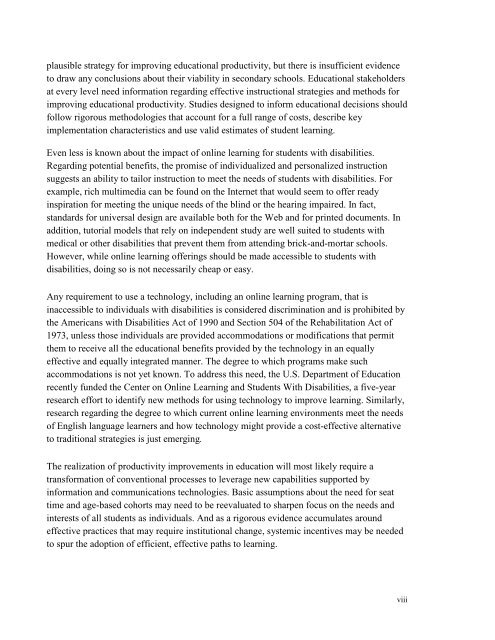Download PDF - SRI International
Download PDF - SRI International
Download PDF - SRI International
You also want an ePaper? Increase the reach of your titles
YUMPU automatically turns print PDFs into web optimized ePapers that Google loves.
plausible strategy for improving educational productivity, but there is insufficient evidence<br />
to draw any conclusions about their viability in secondary schools. Educational stakeholders<br />
at every level need information regarding effective instructional strategies and methods for<br />
improving educational productivity. Studies designed to inform educational decisions should<br />
follow rigorous methodologies that account for a full range of costs, describe key<br />
implementation characteristics and use valid estimates of student learning.<br />
Even less is known about the impact of online learning for students with disabilities.<br />
Regarding potential benefits, the promise of individualized and personalized instruction<br />
suggests an ability to tailor instruction to meet the needs of students with disabilities. For<br />
example, rich multimedia can be found on the Internet that would seem to offer ready<br />
inspiration for meeting the unique needs of the blind or the hearing impaired. In fact,<br />
standards for universal design are available both for the Web and for printed documents. In<br />
addition, tutorial models that rely on independent study are well suited to students with<br />
medical or other disabilities that prevent them from attending brick-and-mortar schools.<br />
However, while online learning offerings should be made accessible to students with<br />
disabilities, doing so is not necessarily cheap or easy.<br />
Any requirement to use a technology, including an online learning program, that is<br />
inaccessible to individuals with disabilities is considered discrimination and is prohibited by<br />
the Americans with Disabilities Act of 1990 and Section 504 of the Rehabilitation Act of<br />
1973, unless those individuals are provided accommodations or modifications that permit<br />
them to receive all the educational benefits provided by the technology in an equally<br />
effective and equally integrated manner. The degree to which programs make such<br />
accommodations is not yet known. To address this need, the U.S. Department of Education<br />
recently funded the Center on Online Learning and Students With Disabilities, a five-year<br />
research effort to identify new methods for using technology to improve learning. Similarly,<br />
research regarding the degree to which current online learning environments meet the needs<br />
of English language learners and how technology might provide a cost-effective alternative<br />
to traditional strategies is just emerging.<br />
The realization of productivity improvements in education will most likely require a<br />
transformation of conventional processes to leverage new capabilities supported by<br />
information and communications technologies. Basic assumptions about the need for seat<br />
time and age-based cohorts may need to be reevaluated to sharpen focus on the needs and<br />
interests of all students as individuals. And as a rigorous evidence accumulates around<br />
effective practices that may require institutional change, systemic incentives may be needed<br />
to spur the adoption of efficient, effective paths to learning.<br />
viii
















